Mergers and Acquisitions: Advantages, Considerations, and Implications
VerifiedAdded on 2023/01/10
|17
|4390
|25
AI Summary
This document provides an in-depth analysis of mergers and acquisitions as a method of corporate expansion. It explores the advantages of M&A, evaluates the use of cash offer and share exchange, and discusses the implications for gearing, financial risk, and cost of borrowing. The document also critically evaluates the main reasons for the high failure rate of M&A in enhancing shareholder value. Real-world examples and case studies are included to support the arguments.
Contribute Materials
Your contribution can guide someone’s learning journey. Share your
documents today.

1
Name:
Course
Professor’s name
University name
City, State
Date of submission
Name:
Course
Professor’s name
University name
City, State
Date of submission
Secure Best Marks with AI Grader
Need help grading? Try our AI Grader for instant feedback on your assignments.
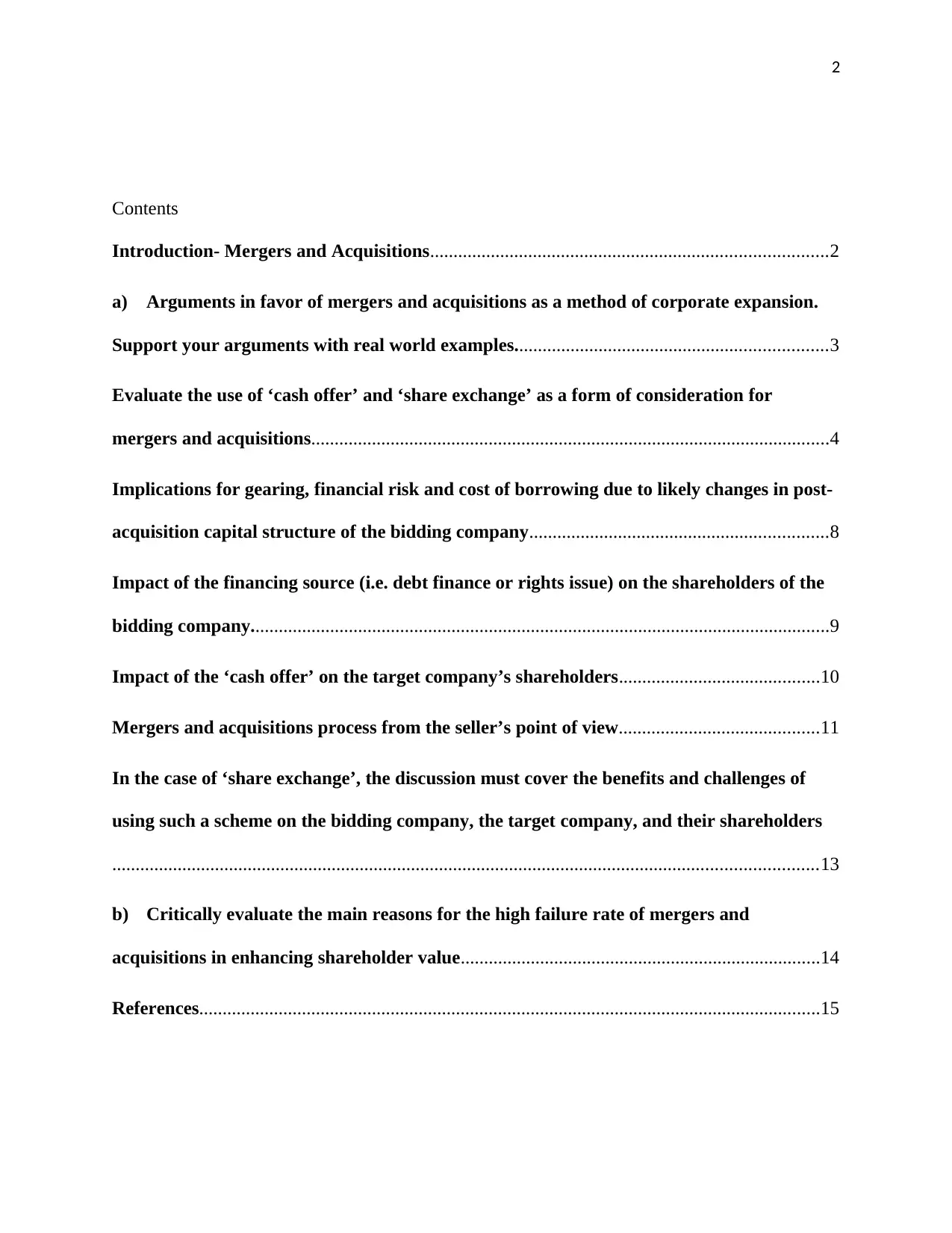
2
Contents
Introduction- Mergers and Acquisitions.....................................................................................2
a) Arguments in favor of mergers and acquisitions as a method of corporate expansion.
Support your arguments with real world examples...................................................................3
Evaluate the use of ‘cash offer’ and ‘share exchange’ as a form of consideration for
mergers and acquisitions...............................................................................................................4
Implications for gearing, financial risk and cost of borrowing due to likely changes in post-
acquisition capital structure of the bidding company................................................................8
Impact of the financing source (i.e. debt finance or rights issue) on the shareholders of the
bidding company............................................................................................................................9
Impact of the ‘cash offer’ on the target company’s shareholders...........................................10
Mergers and acquisitions process from the seller’s point of view...........................................11
In the case of ‘share exchange’, the discussion must cover the benefits and challenges of
using such a scheme on the bidding company, the target company, and their shareholders
.......................................................................................................................................................13
b) Critically evaluate the main reasons for the high failure rate of mergers and
acquisitions in enhancing shareholder value.............................................................................14
References.....................................................................................................................................15
Contents
Introduction- Mergers and Acquisitions.....................................................................................2
a) Arguments in favor of mergers and acquisitions as a method of corporate expansion.
Support your arguments with real world examples...................................................................3
Evaluate the use of ‘cash offer’ and ‘share exchange’ as a form of consideration for
mergers and acquisitions...............................................................................................................4
Implications for gearing, financial risk and cost of borrowing due to likely changes in post-
acquisition capital structure of the bidding company................................................................8
Impact of the financing source (i.e. debt finance or rights issue) on the shareholders of the
bidding company............................................................................................................................9
Impact of the ‘cash offer’ on the target company’s shareholders...........................................10
Mergers and acquisitions process from the seller’s point of view...........................................11
In the case of ‘share exchange’, the discussion must cover the benefits and challenges of
using such a scheme on the bidding company, the target company, and their shareholders
.......................................................................................................................................................13
b) Critically evaluate the main reasons for the high failure rate of mergers and
acquisitions in enhancing shareholder value.............................................................................14
References.....................................................................................................................................15
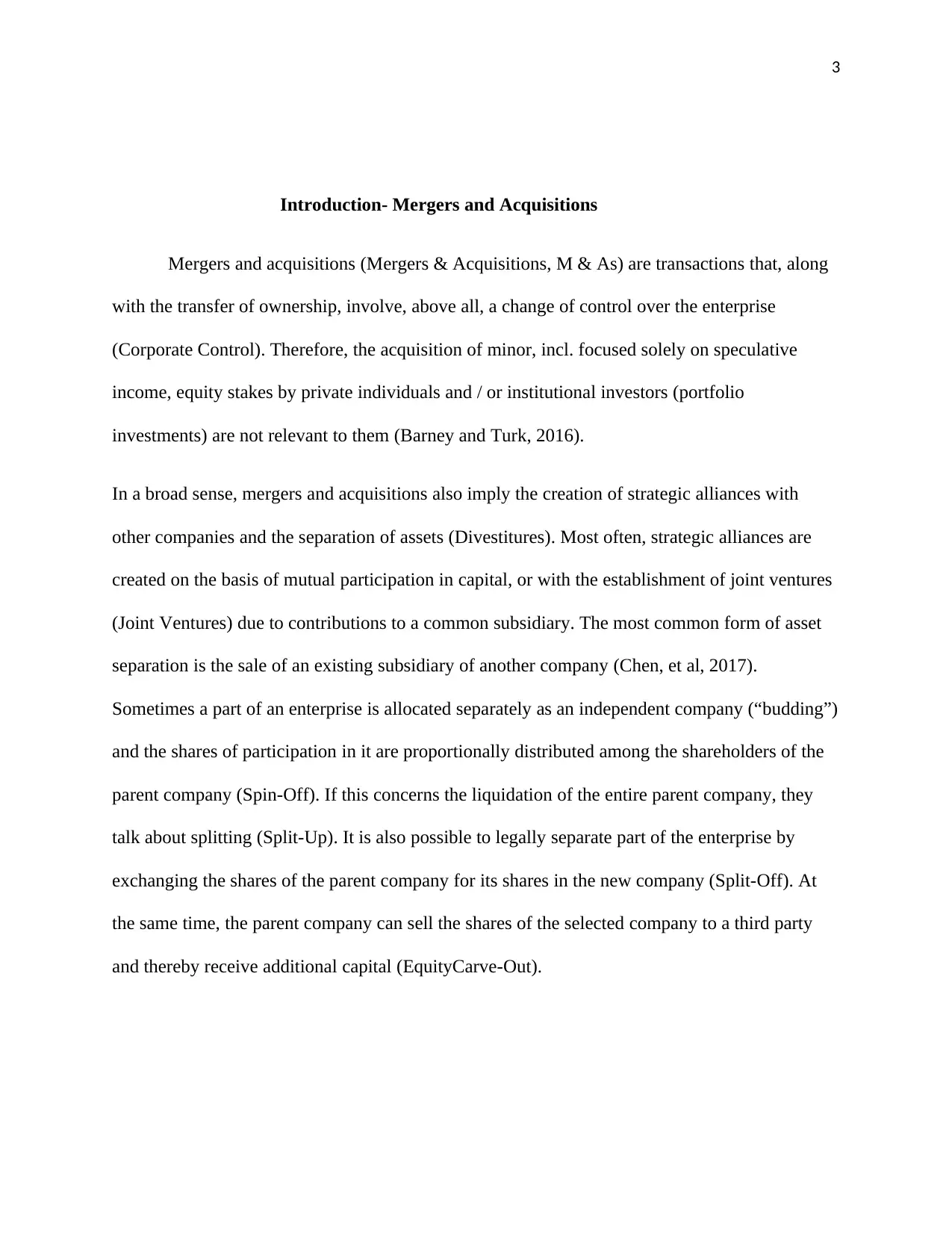
3
Introduction- Mergers and Acquisitions
Mergers and acquisitions (Mergers & Acquisitions, M & As) are transactions that, along
with the transfer of ownership, involve, above all, a change of control over the enterprise
(Corporate Control). Therefore, the acquisition of minor, incl. focused solely on speculative
income, equity stakes by private individuals and / or institutional investors (portfolio
investments) are not relevant to them (Barney and Turk, 2016).
In a broad sense, mergers and acquisitions also imply the creation of strategic alliances with
other companies and the separation of assets (Divestitures). Most often, strategic alliances are
created on the basis of mutual participation in capital, or with the establishment of joint ventures
(Joint Ventures) due to contributions to a common subsidiary. The most common form of asset
separation is the sale of an existing subsidiary of another company (Chen, et al, 2017).
Sometimes a part of an enterprise is allocated separately as an independent company (“budding”)
and the shares of participation in it are proportionally distributed among the shareholders of the
parent company (Spin-Off). If this concerns the liquidation of the entire parent company, they
talk about splitting (Split-Up). It is also possible to legally separate part of the enterprise by
exchanging the shares of the parent company for its shares in the new company (Split-Off). At
the same time, the parent company can sell the shares of the selected company to a third party
and thereby receive additional capital (EquityCarve-Out).
Introduction- Mergers and Acquisitions
Mergers and acquisitions (Mergers & Acquisitions, M & As) are transactions that, along
with the transfer of ownership, involve, above all, a change of control over the enterprise
(Corporate Control). Therefore, the acquisition of minor, incl. focused solely on speculative
income, equity stakes by private individuals and / or institutional investors (portfolio
investments) are not relevant to them (Barney and Turk, 2016).
In a broad sense, mergers and acquisitions also imply the creation of strategic alliances with
other companies and the separation of assets (Divestitures). Most often, strategic alliances are
created on the basis of mutual participation in capital, or with the establishment of joint ventures
(Joint Ventures) due to contributions to a common subsidiary. The most common form of asset
separation is the sale of an existing subsidiary of another company (Chen, et al, 2017).
Sometimes a part of an enterprise is allocated separately as an independent company (“budding”)
and the shares of participation in it are proportionally distributed among the shareholders of the
parent company (Spin-Off). If this concerns the liquidation of the entire parent company, they
talk about splitting (Split-Up). It is also possible to legally separate part of the enterprise by
exchanging the shares of the parent company for its shares in the new company (Split-Off). At
the same time, the parent company can sell the shares of the selected company to a third party
and thereby receive additional capital (EquityCarve-Out).
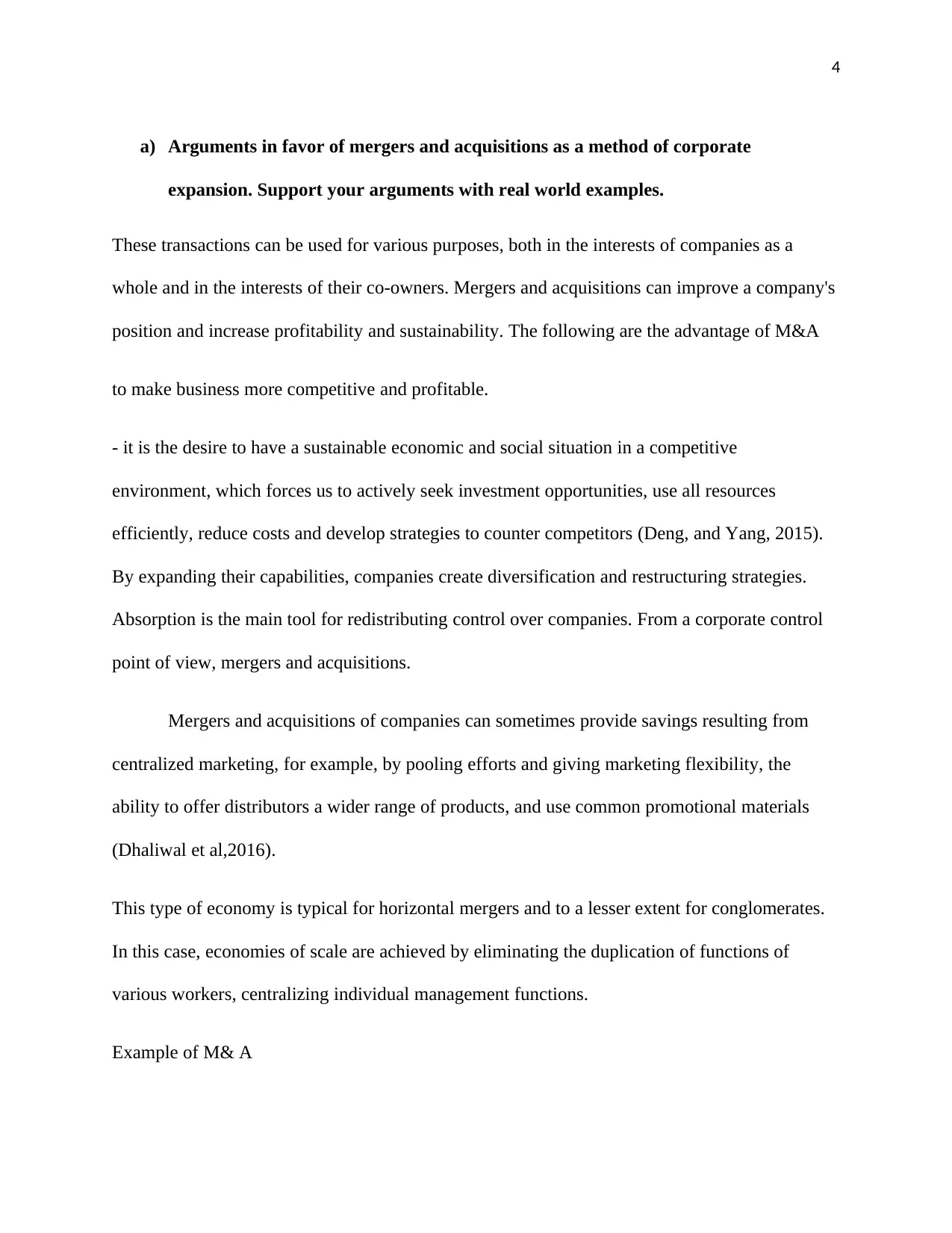
4
a) Arguments in favor of mergers and acquisitions as a method of corporate
expansion. Support your arguments with real world examples.
These transactions can be used for various purposes, both in the interests of companies as a
whole and in the interests of their co-owners. Mergers and acquisitions can improve a company's
position and increase profitability and sustainability. The following are the advantage of M&A
to make business more competitive and profitable.
- it is the desire to have a sustainable economic and social situation in a competitive
environment, which forces us to actively seek investment opportunities, use all resources
efficiently, reduce costs and develop strategies to counter competitors (Deng, and Yang, 2015).
By expanding their capabilities, companies create diversification and restructuring strategies.
Absorption is the main tool for redistributing control over companies. From a corporate control
point of view, mergers and acquisitions.
Mergers and acquisitions of companies can sometimes provide savings resulting from
centralized marketing, for example, by pooling efforts and giving marketing flexibility, the
ability to offer distributors a wider range of products, and use common promotional materials
(Dhaliwal et al,2016).
This type of economy is typical for horizontal mergers and to a lesser extent for conglomerates.
In this case, economies of scale are achieved by eliminating the duplication of functions of
various workers, centralizing individual management functions.
Example of M& A
a) Arguments in favor of mergers and acquisitions as a method of corporate
expansion. Support your arguments with real world examples.
These transactions can be used for various purposes, both in the interests of companies as a
whole and in the interests of their co-owners. Mergers and acquisitions can improve a company's
position and increase profitability and sustainability. The following are the advantage of M&A
to make business more competitive and profitable.
- it is the desire to have a sustainable economic and social situation in a competitive
environment, which forces us to actively seek investment opportunities, use all resources
efficiently, reduce costs and develop strategies to counter competitors (Deng, and Yang, 2015).
By expanding their capabilities, companies create diversification and restructuring strategies.
Absorption is the main tool for redistributing control over companies. From a corporate control
point of view, mergers and acquisitions.
Mergers and acquisitions of companies can sometimes provide savings resulting from
centralized marketing, for example, by pooling efforts and giving marketing flexibility, the
ability to offer distributors a wider range of products, and use common promotional materials
(Dhaliwal et al,2016).
This type of economy is typical for horizontal mergers and to a lesser extent for conglomerates.
In this case, economies of scale are achieved by eliminating the duplication of functions of
various workers, centralizing individual management functions.
Example of M& A
Secure Best Marks with AI Grader
Need help grading? Try our AI Grader for instant feedback on your assignments.
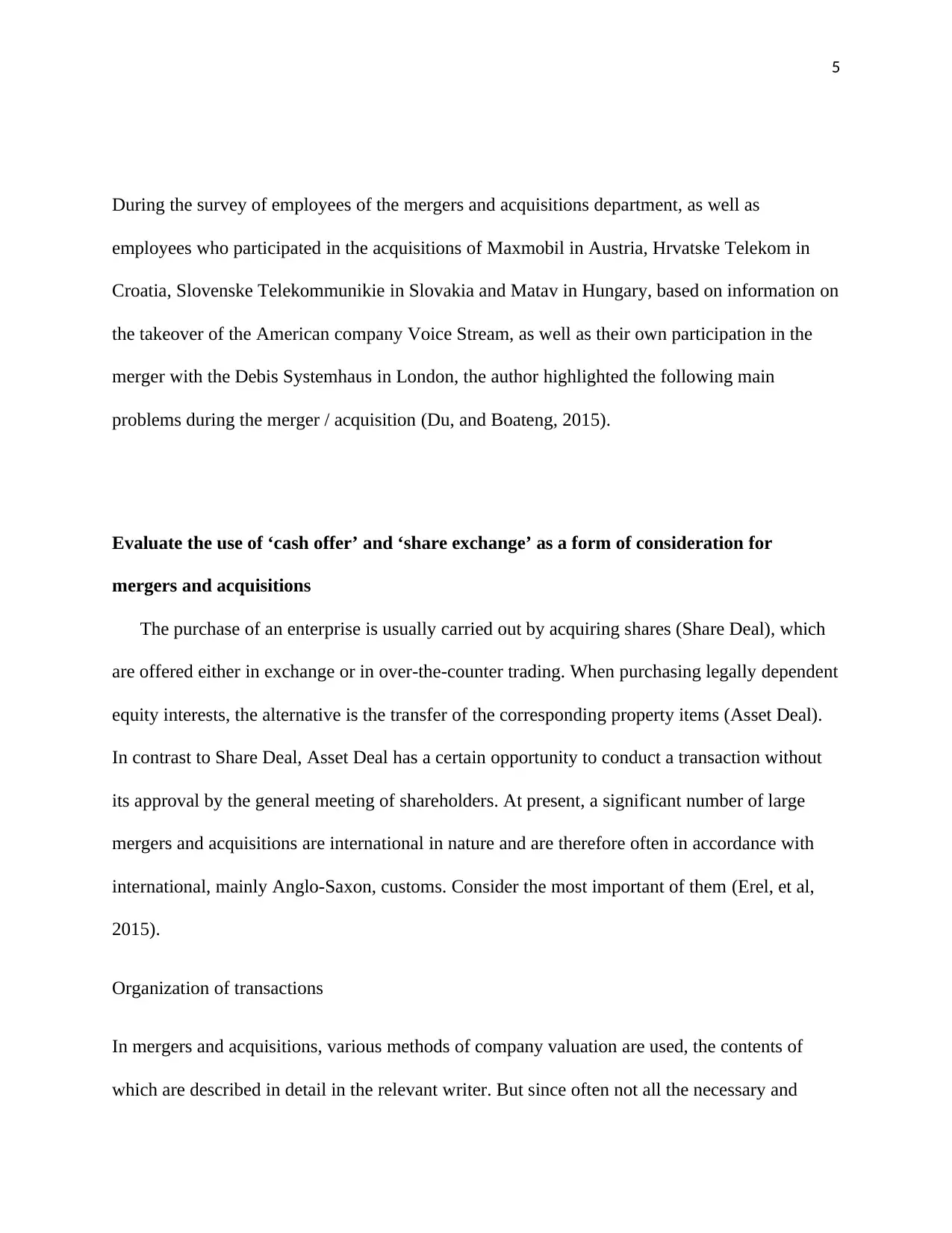
5
During the survey of employees of the mergers and acquisitions department, as well as
employees who participated in the acquisitions of Maxmobil in Austria, Hrvatske Telekom in
Croatia, Slovenske Telekommunikie in Slovakia and Matav in Hungary, based on information on
the takeover of the American company Voice Stream, as well as their own participation in the
merger with the Debis Systemhaus in London, the author highlighted the following main
problems during the merger / acquisition (Du, and Boateng, 2015).
Evaluate the use of ‘cash offer’ and ‘share exchange’ as a form of consideration for
mergers and acquisitions
The purchase of an enterprise is usually carried out by acquiring shares (Share Deal), which
are offered either in exchange or in over-the-counter trading. When purchasing legally dependent
equity interests, the alternative is the transfer of the corresponding property items (Asset Deal).
In contrast to Share Deal, Asset Deal has a certain opportunity to conduct a transaction without
its approval by the general meeting of shareholders. At present, a significant number of large
mergers and acquisitions are international in nature and are therefore often in accordance with
international, mainly Anglo-Saxon, customs. Consider the most important of them (Erel, et al,
2015).
Organization of transactions
In mergers and acquisitions, various methods of company valuation are used, the contents of
which are described in detail in the relevant writer. But since often not all the necessary and
During the survey of employees of the mergers and acquisitions department, as well as
employees who participated in the acquisitions of Maxmobil in Austria, Hrvatske Telekom in
Croatia, Slovenske Telekommunikie in Slovakia and Matav in Hungary, based on information on
the takeover of the American company Voice Stream, as well as their own participation in the
merger with the Debis Systemhaus in London, the author highlighted the following main
problems during the merger / acquisition (Du, and Boateng, 2015).
Evaluate the use of ‘cash offer’ and ‘share exchange’ as a form of consideration for
mergers and acquisitions
The purchase of an enterprise is usually carried out by acquiring shares (Share Deal), which
are offered either in exchange or in over-the-counter trading. When purchasing legally dependent
equity interests, the alternative is the transfer of the corresponding property items (Asset Deal).
In contrast to Share Deal, Asset Deal has a certain opportunity to conduct a transaction without
its approval by the general meeting of shareholders. At present, a significant number of large
mergers and acquisitions are international in nature and are therefore often in accordance with
international, mainly Anglo-Saxon, customs. Consider the most important of them (Erel, et al,
2015).
Organization of transactions
In mergers and acquisitions, various methods of company valuation are used, the contents of
which are described in detail in the relevant writer. But since often not all the necessary and
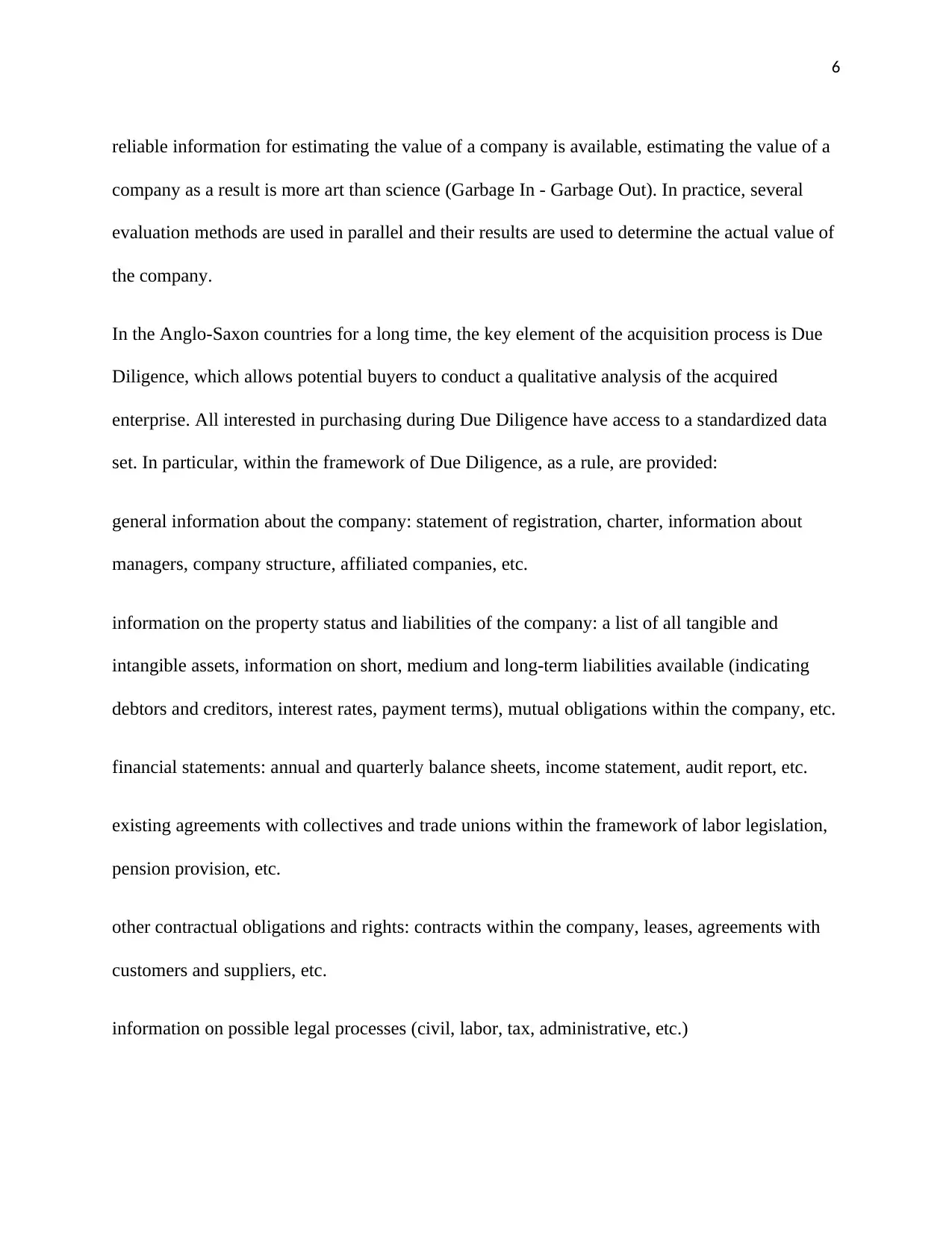
6
reliable information for estimating the value of a company is available, estimating the value of a
company as a result is more art than science (Garbage In - Garbage Out). In practice, several
evaluation methods are used in parallel and their results are used to determine the actual value of
the company.
In the Anglo-Saxon countries for a long time, the key element of the acquisition process is Due
Diligence, which allows potential buyers to conduct a qualitative analysis of the acquired
enterprise. All interested in purchasing during Due Diligence have access to a standardized data
set. In particular, within the framework of Due Diligence, as a rule, are provided:
general information about the company: statement of registration, charter, information about
managers, company structure, affiliated companies, etc.
information on the property status and liabilities of the company: a list of all tangible and
intangible assets, information on short, medium and long-term liabilities available (indicating
debtors and creditors, interest rates, payment terms), mutual obligations within the company, etc.
financial statements: annual and quarterly balance sheets, income statement, audit report, etc.
existing agreements with collectives and trade unions within the framework of labor legislation,
pension provision, etc.
other contractual obligations and rights: contracts within the company, leases, agreements with
customers and suppliers, etc.
information on possible legal processes (civil, labor, tax, administrative, etc.)
reliable information for estimating the value of a company is available, estimating the value of a
company as a result is more art than science (Garbage In - Garbage Out). In practice, several
evaluation methods are used in parallel and their results are used to determine the actual value of
the company.
In the Anglo-Saxon countries for a long time, the key element of the acquisition process is Due
Diligence, which allows potential buyers to conduct a qualitative analysis of the acquired
enterprise. All interested in purchasing during Due Diligence have access to a standardized data
set. In particular, within the framework of Due Diligence, as a rule, are provided:
general information about the company: statement of registration, charter, information about
managers, company structure, affiliated companies, etc.
information on the property status and liabilities of the company: a list of all tangible and
intangible assets, information on short, medium and long-term liabilities available (indicating
debtors and creditors, interest rates, payment terms), mutual obligations within the company, etc.
financial statements: annual and quarterly balance sheets, income statement, audit report, etc.
existing agreements with collectives and trade unions within the framework of labor legislation,
pension provision, etc.
other contractual obligations and rights: contracts within the company, leases, agreements with
customers and suppliers, etc.
information on possible legal processes (civil, labor, tax, administrative, etc.)
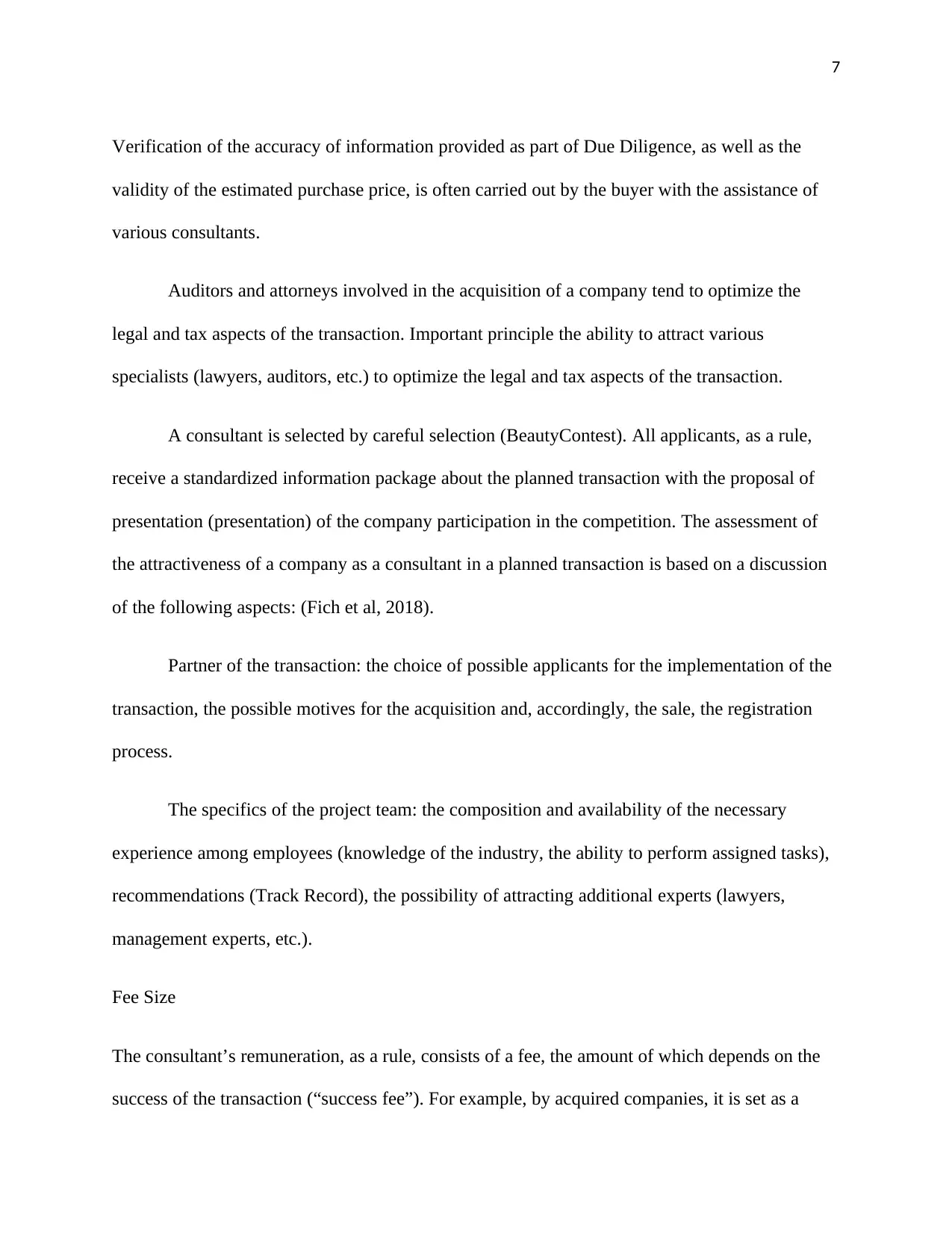
7
Verification of the accuracy of information provided as part of Due Diligence, as well as the
validity of the estimated purchase price, is often carried out by the buyer with the assistance of
various consultants.
Auditors and attorneys involved in the acquisition of a company tend to optimize the
legal and tax aspects of the transaction. Important principle the ability to attract various
specialists (lawyers, auditors, etc.) to optimize the legal and tax aspects of the transaction.
A consultant is selected by careful selection (BeautyContest). All applicants, as a rule,
receive a standardized information package about the planned transaction with the proposal of
presentation (presentation) of the company participation in the competition. The assessment of
the attractiveness of a company as a consultant in a planned transaction is based on a discussion
of the following aspects: (Fich et al, 2018).
Partner of the transaction: the choice of possible applicants for the implementation of the
transaction, the possible motives for the acquisition and, accordingly, the sale, the registration
process.
The specifics of the project team: the composition and availability of the necessary
experience among employees (knowledge of the industry, the ability to perform assigned tasks),
recommendations (Track Record), the possibility of attracting additional experts (lawyers,
management experts, etc.).
Fee Size
The consultant’s remuneration, as a rule, consists of a fee, the amount of which depends on the
success of the transaction (“success fee”). For example, by acquired companies, it is set as a
Verification of the accuracy of information provided as part of Due Diligence, as well as the
validity of the estimated purchase price, is often carried out by the buyer with the assistance of
various consultants.
Auditors and attorneys involved in the acquisition of a company tend to optimize the
legal and tax aspects of the transaction. Important principle the ability to attract various
specialists (lawyers, auditors, etc.) to optimize the legal and tax aspects of the transaction.
A consultant is selected by careful selection (BeautyContest). All applicants, as a rule,
receive a standardized information package about the planned transaction with the proposal of
presentation (presentation) of the company participation in the competition. The assessment of
the attractiveness of a company as a consultant in a planned transaction is based on a discussion
of the following aspects: (Fich et al, 2018).
Partner of the transaction: the choice of possible applicants for the implementation of the
transaction, the possible motives for the acquisition and, accordingly, the sale, the registration
process.
The specifics of the project team: the composition and availability of the necessary
experience among employees (knowledge of the industry, the ability to perform assigned tasks),
recommendations (Track Record), the possibility of attracting additional experts (lawyers,
management experts, etc.).
Fee Size
The consultant’s remuneration, as a rule, consists of a fee, the amount of which depends on the
success of the transaction (“success fee”). For example, by acquired companies, it is set as a
Paraphrase This Document
Need a fresh take? Get an instant paraphrase of this document with our AI Paraphraser
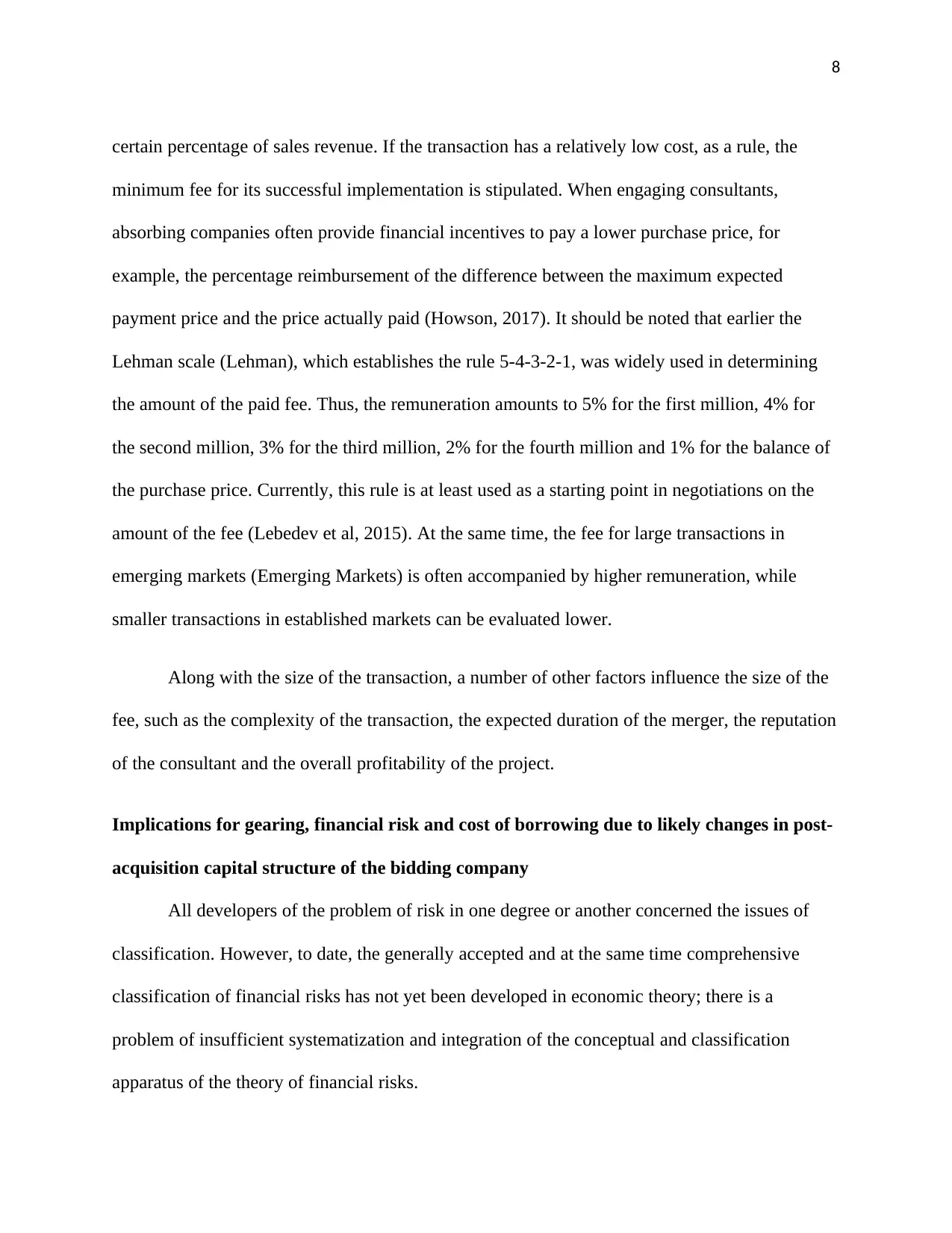
8
certain percentage of sales revenue. If the transaction has a relatively low cost, as a rule, the
minimum fee for its successful implementation is stipulated. When engaging consultants,
absorbing companies often provide financial incentives to pay a lower purchase price, for
example, the percentage reimbursement of the difference between the maximum expected
payment price and the price actually paid (Howson, 2017). It should be noted that earlier the
Lehman scale (Lehman), which establishes the rule 5-4-3-2-1, was widely used in determining
the amount of the paid fee. Thus, the remuneration amounts to 5% for the first million, 4% for
the second million, 3% for the third million, 2% for the fourth million and 1% for the balance of
the purchase price. Currently, this rule is at least used as a starting point in negotiations on the
amount of the fee (Lebedev et al, 2015). At the same time, the fee for large transactions in
emerging markets (Emerging Markets) is often accompanied by higher remuneration, while
smaller transactions in established markets can be evaluated lower.
Along with the size of the transaction, a number of other factors influence the size of the
fee, such as the complexity of the transaction, the expected duration of the merger, the reputation
of the consultant and the overall profitability of the project.
Implications for gearing, financial risk and cost of borrowing due to likely changes in post-
acquisition capital structure of the bidding company
All developers of the problem of risk in one degree or another concerned the issues of
classification. However, to date, the generally accepted and at the same time comprehensive
classification of financial risks has not yet been developed in economic theory; there is a
problem of insufficient systematization and integration of the conceptual and classification
apparatus of the theory of financial risks.
certain percentage of sales revenue. If the transaction has a relatively low cost, as a rule, the
minimum fee for its successful implementation is stipulated. When engaging consultants,
absorbing companies often provide financial incentives to pay a lower purchase price, for
example, the percentage reimbursement of the difference between the maximum expected
payment price and the price actually paid (Howson, 2017). It should be noted that earlier the
Lehman scale (Lehman), which establishes the rule 5-4-3-2-1, was widely used in determining
the amount of the paid fee. Thus, the remuneration amounts to 5% for the first million, 4% for
the second million, 3% for the third million, 2% for the fourth million and 1% for the balance of
the purchase price. Currently, this rule is at least used as a starting point in negotiations on the
amount of the fee (Lebedev et al, 2015). At the same time, the fee for large transactions in
emerging markets (Emerging Markets) is often accompanied by higher remuneration, while
smaller transactions in established markets can be evaluated lower.
Along with the size of the transaction, a number of other factors influence the size of the
fee, such as the complexity of the transaction, the expected duration of the merger, the reputation
of the consultant and the overall profitability of the project.
Implications for gearing, financial risk and cost of borrowing due to likely changes in post-
acquisition capital structure of the bidding company
All developers of the problem of risk in one degree or another concerned the issues of
classification. However, to date, the generally accepted and at the same time comprehensive
classification of financial risks has not yet been developed in economic theory; there is a
problem of insufficient systematization and integration of the conceptual and classification
apparatus of the theory of financial risks.
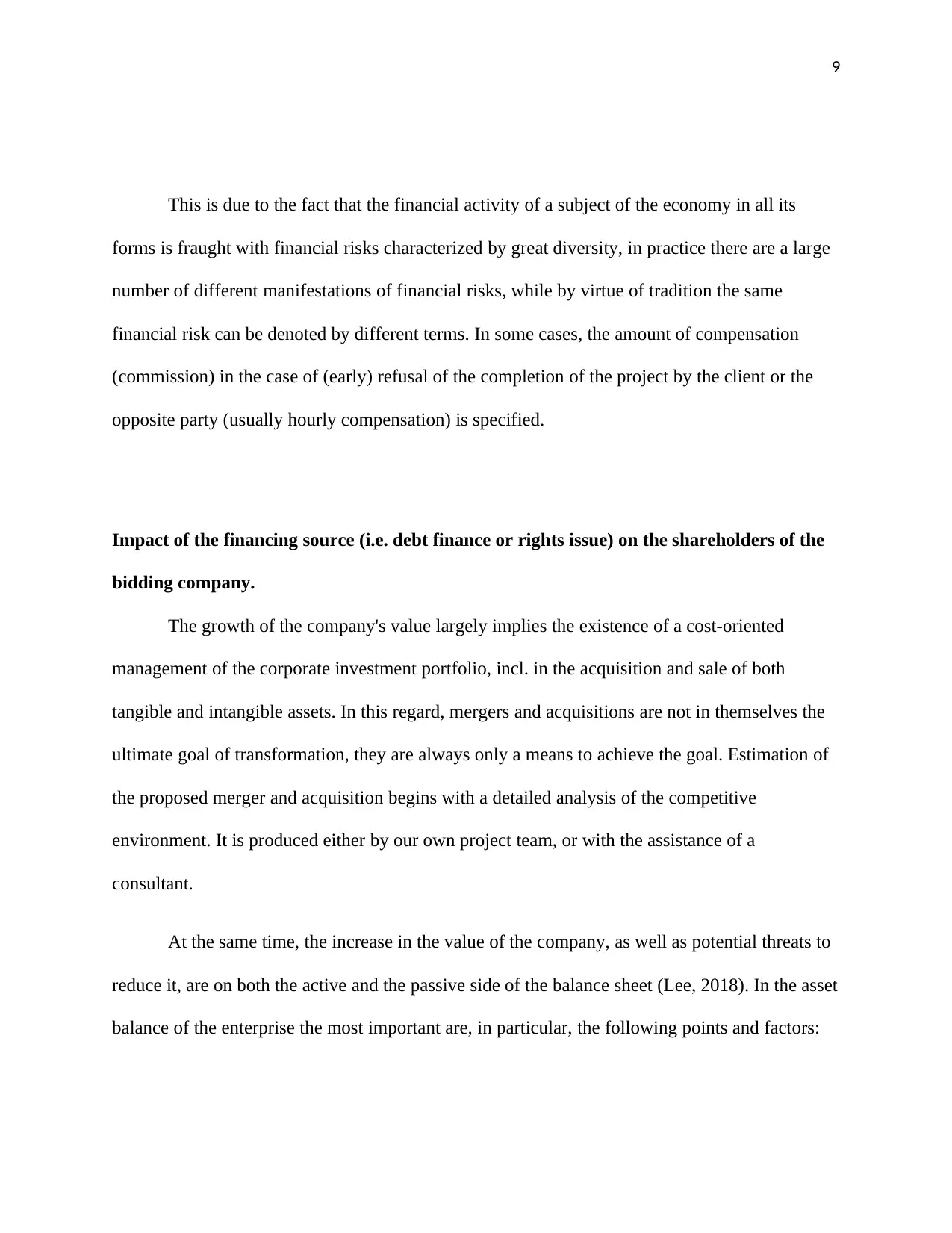
9
This is due to the fact that the financial activity of a subject of the economy in all its
forms is fraught with financial risks characterized by great diversity, in practice there are a large
number of different manifestations of financial risks, while by virtue of tradition the same
financial risk can be denoted by different terms. In some cases, the amount of compensation
(commission) in the case of (early) refusal of the completion of the project by the client or the
opposite party (usually hourly compensation) is specified.
Impact of the financing source (i.e. debt finance or rights issue) on the shareholders of the
bidding company.
The growth of the company's value largely implies the existence of a cost-oriented
management of the corporate investment portfolio, incl. in the acquisition and sale of both
tangible and intangible assets. In this regard, mergers and acquisitions are not in themselves the
ultimate goal of transformation, they are always only a means to achieve the goal. Estimation of
the proposed merger and acquisition begins with a detailed analysis of the competitive
environment. It is produced either by our own project team, or with the assistance of a
consultant.
At the same time, the increase in the value of the company, as well as potential threats to
reduce it, are on both the active and the passive side of the balance sheet (Lee, 2018). In the asset
balance of the enterprise the most important are, in particular, the following points and factors:
This is due to the fact that the financial activity of a subject of the economy in all its
forms is fraught with financial risks characterized by great diversity, in practice there are a large
number of different manifestations of financial risks, while by virtue of tradition the same
financial risk can be denoted by different terms. In some cases, the amount of compensation
(commission) in the case of (early) refusal of the completion of the project by the client or the
opposite party (usually hourly compensation) is specified.
Impact of the financing source (i.e. debt finance or rights issue) on the shareholders of the
bidding company.
The growth of the company's value largely implies the existence of a cost-oriented
management of the corporate investment portfolio, incl. in the acquisition and sale of both
tangible and intangible assets. In this regard, mergers and acquisitions are not in themselves the
ultimate goal of transformation, they are always only a means to achieve the goal. Estimation of
the proposed merger and acquisition begins with a detailed analysis of the competitive
environment. It is produced either by our own project team, or with the assistance of a
consultant.
At the same time, the increase in the value of the company, as well as potential threats to
reduce it, are on both the active and the passive side of the balance sheet (Lee, 2018). In the asset
balance of the enterprise the most important are, in particular, the following points and factors:
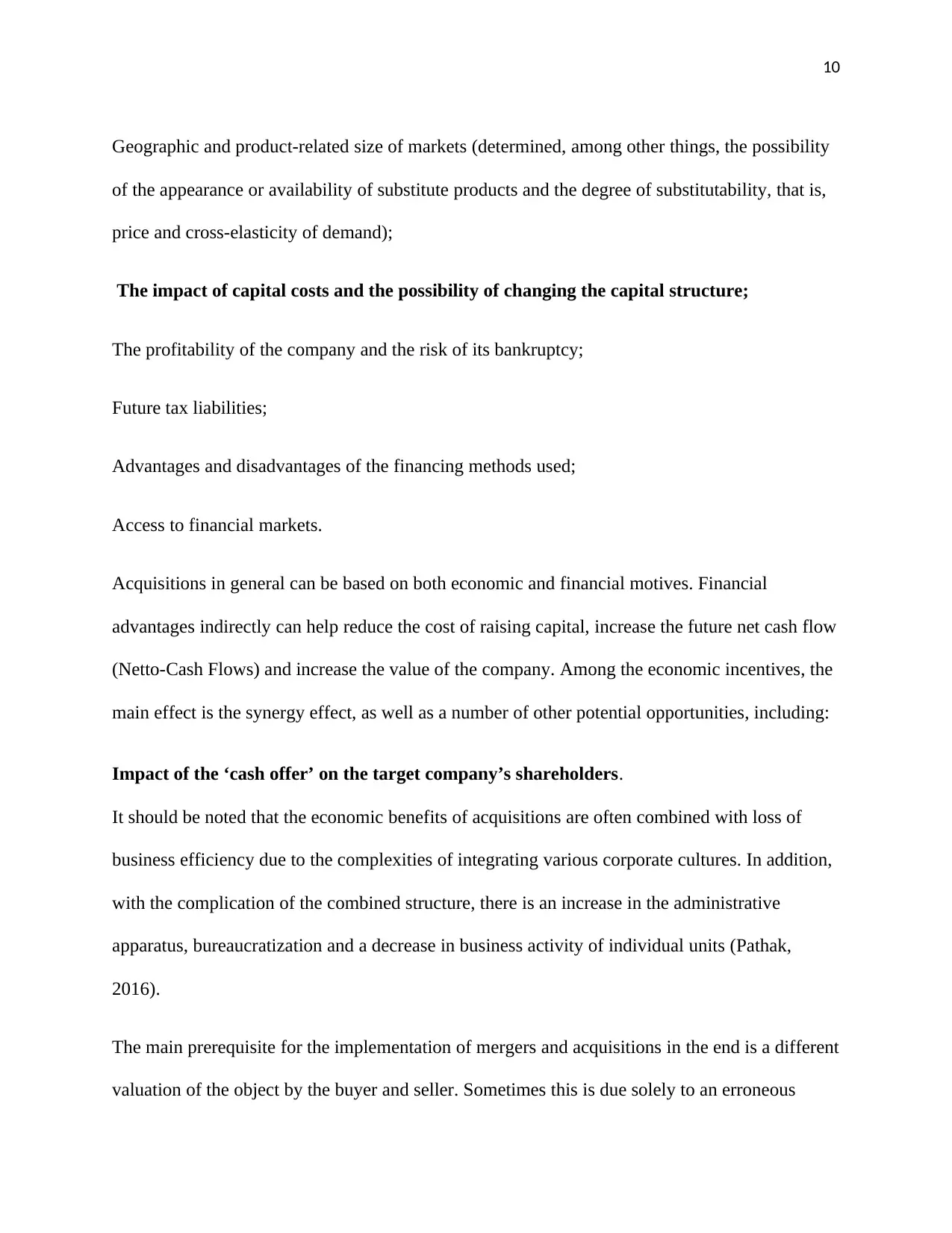
10
Geographic and product-related size of markets (determined, among other things, the possibility
of the appearance or availability of substitute products and the degree of substitutability, that is,
price and cross-elasticity of demand);
The impact of capital costs and the possibility of changing the capital structure;
The profitability of the company and the risk of its bankruptcy;
Future tax liabilities;
Advantages and disadvantages of the financing methods used;
Access to financial markets.
Acquisitions in general can be based on both economic and financial motives. Financial
advantages indirectly can help reduce the cost of raising capital, increase the future net cash flow
(Netto-Cash Flows) and increase the value of the company. Among the economic incentives, the
main effect is the synergy effect, as well as a number of other potential opportunities, including:
Impact of the ‘cash offer’ on the target company’s shareholders.
It should be noted that the economic benefits of acquisitions are often combined with loss of
business efficiency due to the complexities of integrating various corporate cultures. In addition,
with the complication of the combined structure, there is an increase in the administrative
apparatus, bureaucratization and a decrease in business activity of individual units (Pathak,
2016).
The main prerequisite for the implementation of mergers and acquisitions in the end is a different
valuation of the object by the buyer and seller. Sometimes this is due solely to an erroneous
Geographic and product-related size of markets (determined, among other things, the possibility
of the appearance or availability of substitute products and the degree of substitutability, that is,
price and cross-elasticity of demand);
The impact of capital costs and the possibility of changing the capital structure;
The profitability of the company and the risk of its bankruptcy;
Future tax liabilities;
Advantages and disadvantages of the financing methods used;
Access to financial markets.
Acquisitions in general can be based on both economic and financial motives. Financial
advantages indirectly can help reduce the cost of raising capital, increase the future net cash flow
(Netto-Cash Flows) and increase the value of the company. Among the economic incentives, the
main effect is the synergy effect, as well as a number of other potential opportunities, including:
Impact of the ‘cash offer’ on the target company’s shareholders.
It should be noted that the economic benefits of acquisitions are often combined with loss of
business efficiency due to the complexities of integrating various corporate cultures. In addition,
with the complication of the combined structure, there is an increase in the administrative
apparatus, bureaucratization and a decrease in business activity of individual units (Pathak,
2016).
The main prerequisite for the implementation of mergers and acquisitions in the end is a different
valuation of the object by the buyer and seller. Sometimes this is due solely to an erroneous
Secure Best Marks with AI Grader
Need help grading? Try our AI Grader for instant feedback on your assignments.
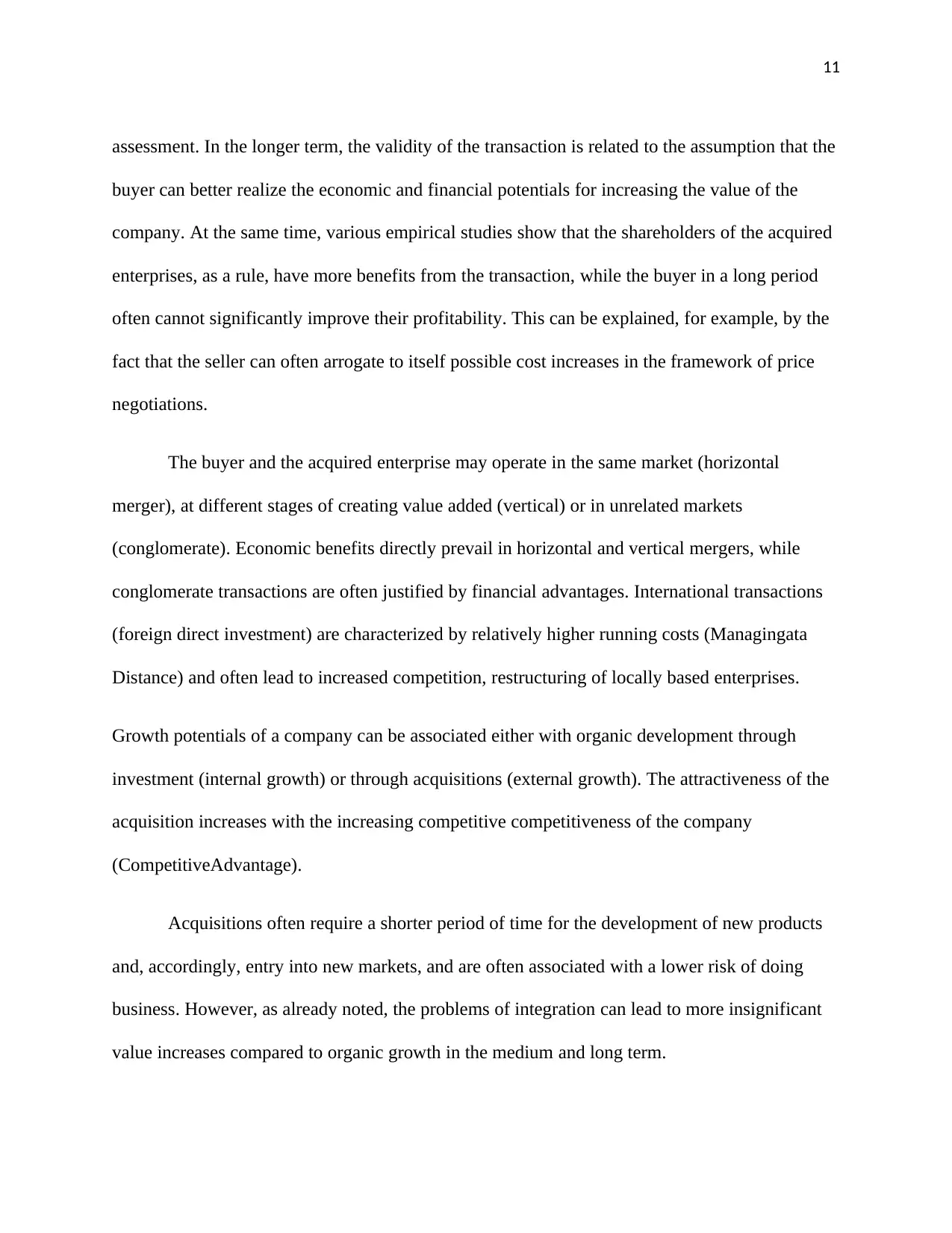
11
assessment. In the longer term, the validity of the transaction is related to the assumption that the
buyer can better realize the economic and financial potentials for increasing the value of the
company. At the same time, various empirical studies show that the shareholders of the acquired
enterprises, as a rule, have more benefits from the transaction, while the buyer in a long period
often cannot significantly improve their profitability. This can be explained, for example, by the
fact that the seller can often arrogate to itself possible cost increases in the framework of price
negotiations.
The buyer and the acquired enterprise may operate in the same market (horizontal
merger), at different stages of creating value added (vertical) or in unrelated markets
(conglomerate). Economic benefits directly prevail in horizontal and vertical mergers, while
conglomerate transactions are often justified by financial advantages. International transactions
(foreign direct investment) are characterized by relatively higher running costs (Managingata
Distance) and often lead to increased competition, restructuring of locally based enterprises.
Growth potentials of a company can be associated either with organic development through
investment (internal growth) or through acquisitions (external growth). The attractiveness of the
acquisition increases with the increasing competitive competitiveness of the company
(CompetitiveAdvantage).
Acquisitions often require a shorter period of time for the development of new products
and, accordingly, entry into new markets, and are often associated with a lower risk of doing
business. However, as already noted, the problems of integration can lead to more insignificant
value increases compared to organic growth in the medium and long term.
assessment. In the longer term, the validity of the transaction is related to the assumption that the
buyer can better realize the economic and financial potentials for increasing the value of the
company. At the same time, various empirical studies show that the shareholders of the acquired
enterprises, as a rule, have more benefits from the transaction, while the buyer in a long period
often cannot significantly improve their profitability. This can be explained, for example, by the
fact that the seller can often arrogate to itself possible cost increases in the framework of price
negotiations.
The buyer and the acquired enterprise may operate in the same market (horizontal
merger), at different stages of creating value added (vertical) or in unrelated markets
(conglomerate). Economic benefits directly prevail in horizontal and vertical mergers, while
conglomerate transactions are often justified by financial advantages. International transactions
(foreign direct investment) are characterized by relatively higher running costs (Managingata
Distance) and often lead to increased competition, restructuring of locally based enterprises.
Growth potentials of a company can be associated either with organic development through
investment (internal growth) or through acquisitions (external growth). The attractiveness of the
acquisition increases with the increasing competitive competitiveness of the company
(CompetitiveAdvantage).
Acquisitions often require a shorter period of time for the development of new products
and, accordingly, entry into new markets, and are often associated with a lower risk of doing
business. However, as already noted, the problems of integration can lead to more insignificant
value increases compared to organic growth in the medium and long term.
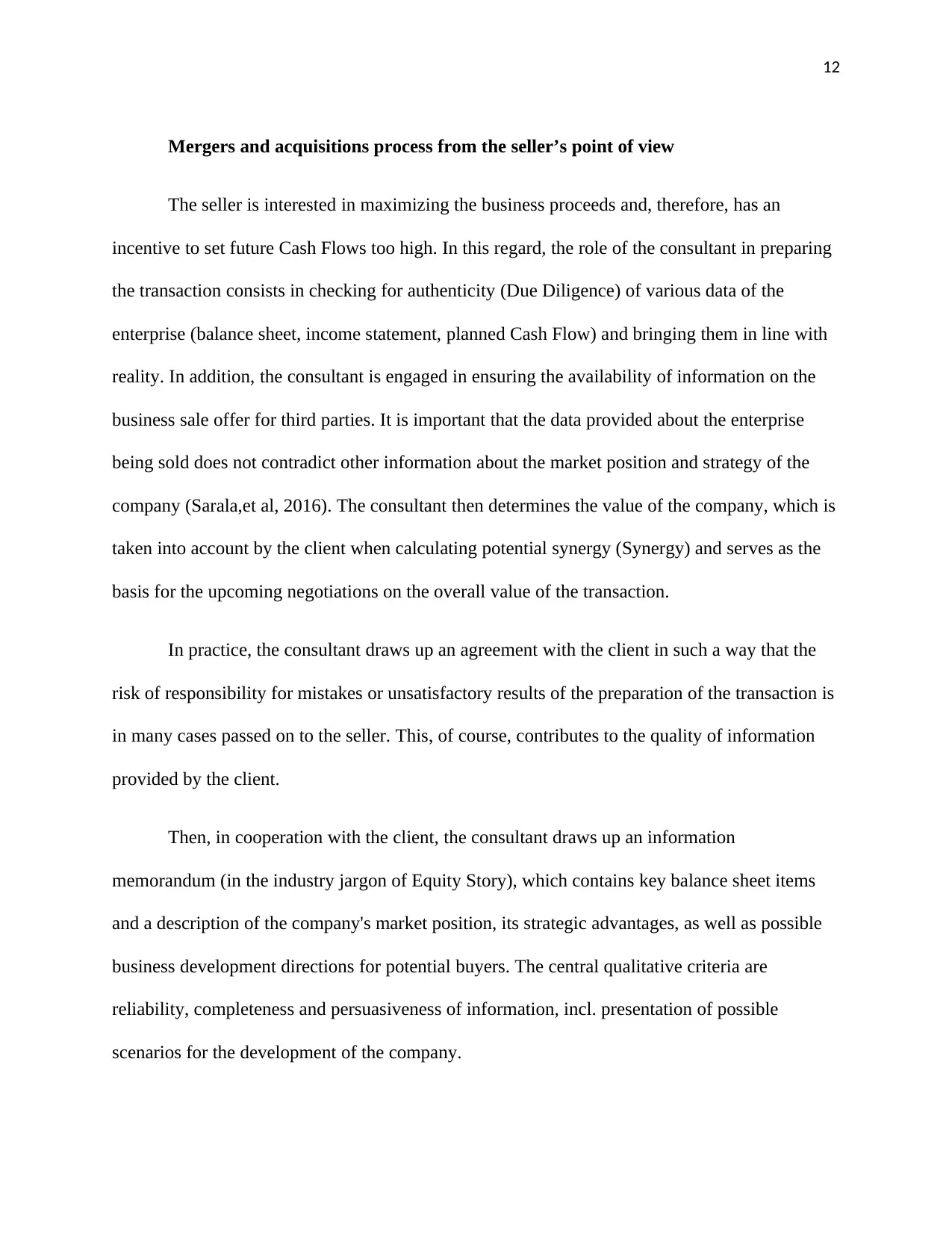
12
Mergers and acquisitions process from the seller’s point of view
The seller is interested in maximizing the business proceeds and, therefore, has an
incentive to set future Cash Flows too high. In this regard, the role of the consultant in preparing
the transaction consists in checking for authenticity (Due Diligence) of various data of the
enterprise (balance sheet, income statement, planned Cash Flow) and bringing them in line with
reality. In addition, the consultant is engaged in ensuring the availability of information on the
business sale offer for third parties. It is important that the data provided about the enterprise
being sold does not contradict other information about the market position and strategy of the
company (Sarala,et al, 2016). The consultant then determines the value of the company, which is
taken into account by the client when calculating potential synergy (Synergy) and serves as the
basis for the upcoming negotiations on the overall value of the transaction.
In practice, the consultant draws up an agreement with the client in such a way that the
risk of responsibility for mistakes or unsatisfactory results of the preparation of the transaction is
in many cases passed on to the seller. This, of course, contributes to the quality of information
provided by the client.
Then, in cooperation with the client, the consultant draws up an information
memorandum (in the industry jargon of Equity Story), which contains key balance sheet items
and a description of the company's market position, its strategic advantages, as well as possible
business development directions for potential buyers. The central qualitative criteria are
reliability, completeness and persuasiveness of information, incl. presentation of possible
scenarios for the development of the company.
Mergers and acquisitions process from the seller’s point of view
The seller is interested in maximizing the business proceeds and, therefore, has an
incentive to set future Cash Flows too high. In this regard, the role of the consultant in preparing
the transaction consists in checking for authenticity (Due Diligence) of various data of the
enterprise (balance sheet, income statement, planned Cash Flow) and bringing them in line with
reality. In addition, the consultant is engaged in ensuring the availability of information on the
business sale offer for third parties. It is important that the data provided about the enterprise
being sold does not contradict other information about the market position and strategy of the
company (Sarala,et al, 2016). The consultant then determines the value of the company, which is
taken into account by the client when calculating potential synergy (Synergy) and serves as the
basis for the upcoming negotiations on the overall value of the transaction.
In practice, the consultant draws up an agreement with the client in such a way that the
risk of responsibility for mistakes or unsatisfactory results of the preparation of the transaction is
in many cases passed on to the seller. This, of course, contributes to the quality of information
provided by the client.
Then, in cooperation with the client, the consultant draws up an information
memorandum (in the industry jargon of Equity Story), which contains key balance sheet items
and a description of the company's market position, its strategic advantages, as well as possible
business development directions for potential buyers. The central qualitative criteria are
reliability, completeness and persuasiveness of information, incl. presentation of possible
scenarios for the development of the company.
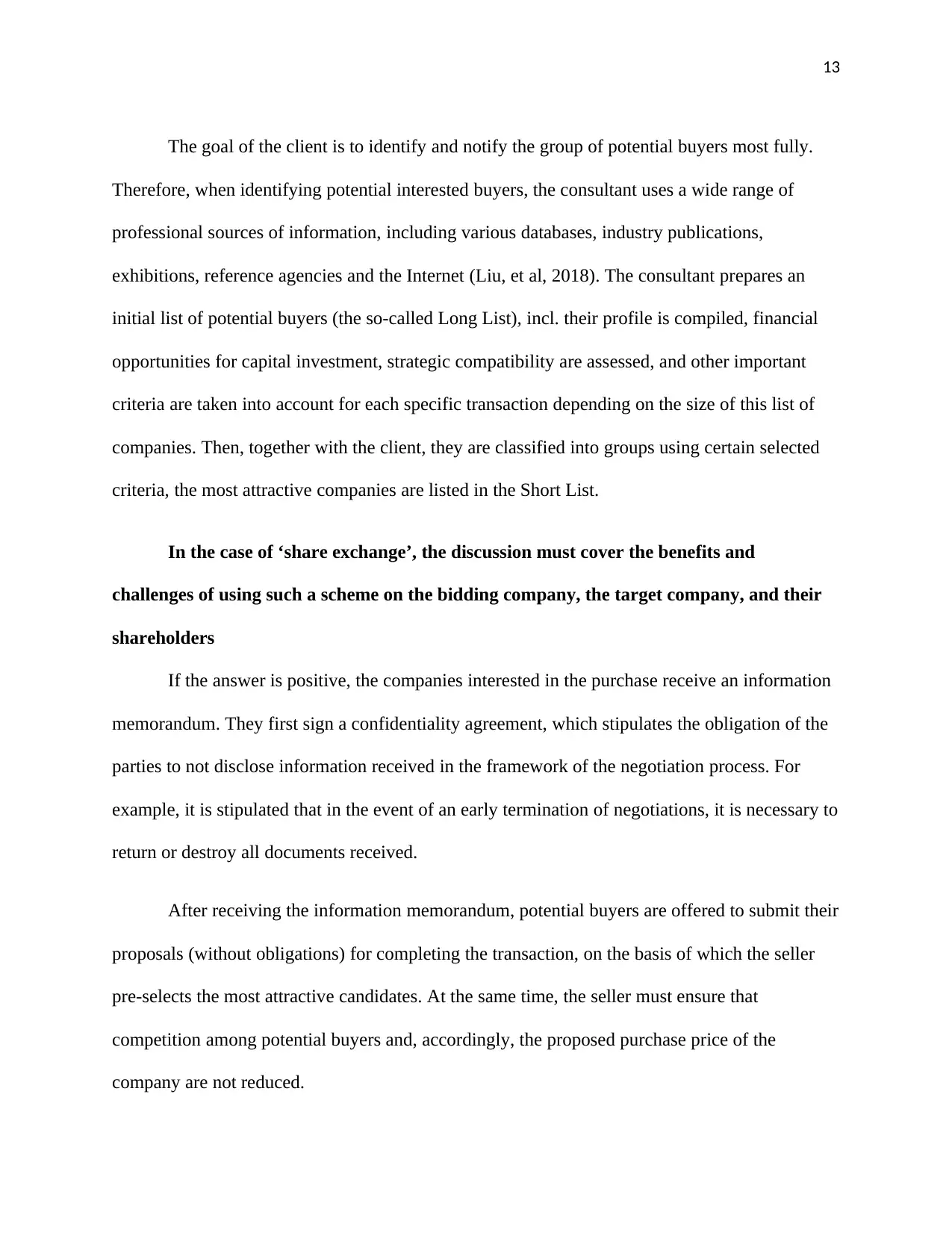
13
The goal of the client is to identify and notify the group of potential buyers most fully.
Therefore, when identifying potential interested buyers, the consultant uses a wide range of
professional sources of information, including various databases, industry publications,
exhibitions, reference agencies and the Internet (Liu, et al, 2018). The consultant prepares an
initial list of potential buyers (the so-called Long List), incl. their profile is compiled, financial
opportunities for capital investment, strategic compatibility are assessed, and other important
criteria are taken into account for each specific transaction depending on the size of this list of
companies. Then, together with the client, they are classified into groups using certain selected
criteria, the most attractive companies are listed in the Short List.
In the case of ‘share exchange’, the discussion must cover the benefits and
challenges of using such a scheme on the bidding company, the target company, and their
shareholders
If the answer is positive, the companies interested in the purchase receive an information
memorandum. They first sign a confidentiality agreement, which stipulates the obligation of the
parties to not disclose information received in the framework of the negotiation process. For
example, it is stipulated that in the event of an early termination of negotiations, it is necessary to
return or destroy all documents received.
After receiving the information memorandum, potential buyers are offered to submit their
proposals (without obligations) for completing the transaction, on the basis of which the seller
pre-selects the most attractive candidates. At the same time, the seller must ensure that
competition among potential buyers and, accordingly, the proposed purchase price of the
company are not reduced.
The goal of the client is to identify and notify the group of potential buyers most fully.
Therefore, when identifying potential interested buyers, the consultant uses a wide range of
professional sources of information, including various databases, industry publications,
exhibitions, reference agencies and the Internet (Liu, et al, 2018). The consultant prepares an
initial list of potential buyers (the so-called Long List), incl. their profile is compiled, financial
opportunities for capital investment, strategic compatibility are assessed, and other important
criteria are taken into account for each specific transaction depending on the size of this list of
companies. Then, together with the client, they are classified into groups using certain selected
criteria, the most attractive companies are listed in the Short List.
In the case of ‘share exchange’, the discussion must cover the benefits and
challenges of using such a scheme on the bidding company, the target company, and their
shareholders
If the answer is positive, the companies interested in the purchase receive an information
memorandum. They first sign a confidentiality agreement, which stipulates the obligation of the
parties to not disclose information received in the framework of the negotiation process. For
example, it is stipulated that in the event of an early termination of negotiations, it is necessary to
return or destroy all documents received.
After receiving the information memorandum, potential buyers are offered to submit their
proposals (without obligations) for completing the transaction, on the basis of which the seller
pre-selects the most attractive candidates. At the same time, the seller must ensure that
competition among potential buyers and, accordingly, the proposed purchase price of the
company are not reduced.
Paraphrase This Document
Need a fresh take? Get an instant paraphrase of this document with our AI Paraphraser
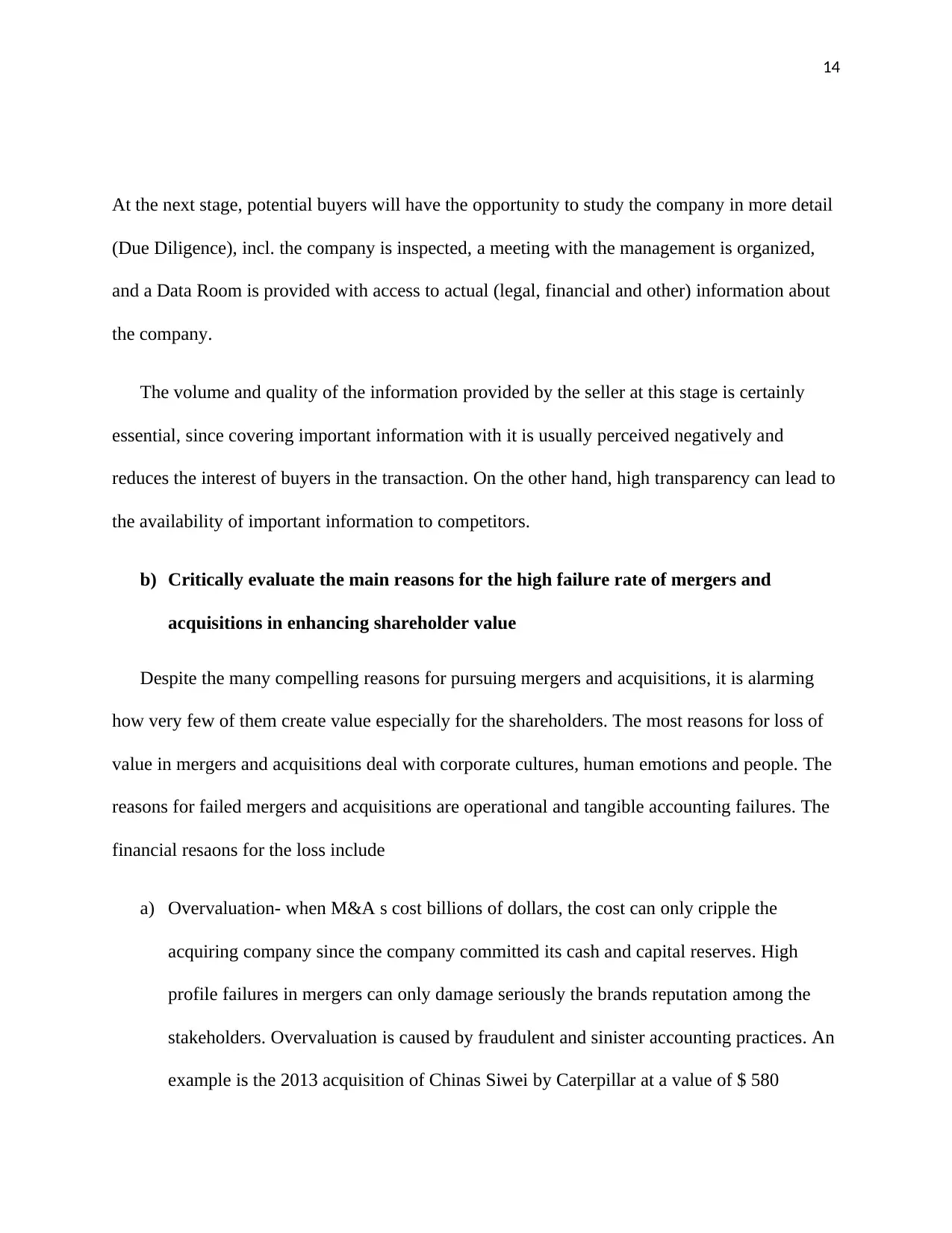
14
At the next stage, potential buyers will have the opportunity to study the company in more detail
(Due Diligence), incl. the company is inspected, a meeting with the management is organized,
and a Data Room is provided with access to actual (legal, financial and other) information about
the company.
The volume and quality of the information provided by the seller at this stage is certainly
essential, since covering important information with it is usually perceived negatively and
reduces the interest of buyers in the transaction. On the other hand, high transparency can lead to
the availability of important information to competitors.
b) Critically evaluate the main reasons for the high failure rate of mergers and
acquisitions in enhancing shareholder value
Despite the many compelling reasons for pursuing mergers and acquisitions, it is alarming
how very few of them create value especially for the shareholders. The most reasons for loss of
value in mergers and acquisitions deal with corporate cultures, human emotions and people. The
reasons for failed mergers and acquisitions are operational and tangible accounting failures. The
financial resaons for the loss include
a) Overvaluation- when M&A s cost billions of dollars, the cost can only cripple the
acquiring company since the company committed its cash and capital reserves. High
profile failures in mergers can only damage seriously the brands reputation among the
stakeholders. Overvaluation is caused by fraudulent and sinister accounting practices. An
example is the 2013 acquisition of Chinas Siwei by Caterpillar at a value of $ 580
At the next stage, potential buyers will have the opportunity to study the company in more detail
(Due Diligence), incl. the company is inspected, a meeting with the management is organized,
and a Data Room is provided with access to actual (legal, financial and other) information about
the company.
The volume and quality of the information provided by the seller at this stage is certainly
essential, since covering important information with it is usually perceived negatively and
reduces the interest of buyers in the transaction. On the other hand, high transparency can lead to
the availability of important information to competitors.
b) Critically evaluate the main reasons for the high failure rate of mergers and
acquisitions in enhancing shareholder value
Despite the many compelling reasons for pursuing mergers and acquisitions, it is alarming
how very few of them create value especially for the shareholders. The most reasons for loss of
value in mergers and acquisitions deal with corporate cultures, human emotions and people. The
reasons for failed mergers and acquisitions are operational and tangible accounting failures. The
financial resaons for the loss include
a) Overvaluation- when M&A s cost billions of dollars, the cost can only cripple the
acquiring company since the company committed its cash and capital reserves. High
profile failures in mergers can only damage seriously the brands reputation among the
stakeholders. Overvaluation is caused by fraudulent and sinister accounting practices. An
example is the 2013 acquisition of Chinas Siwei by Caterpillar at a value of $ 580
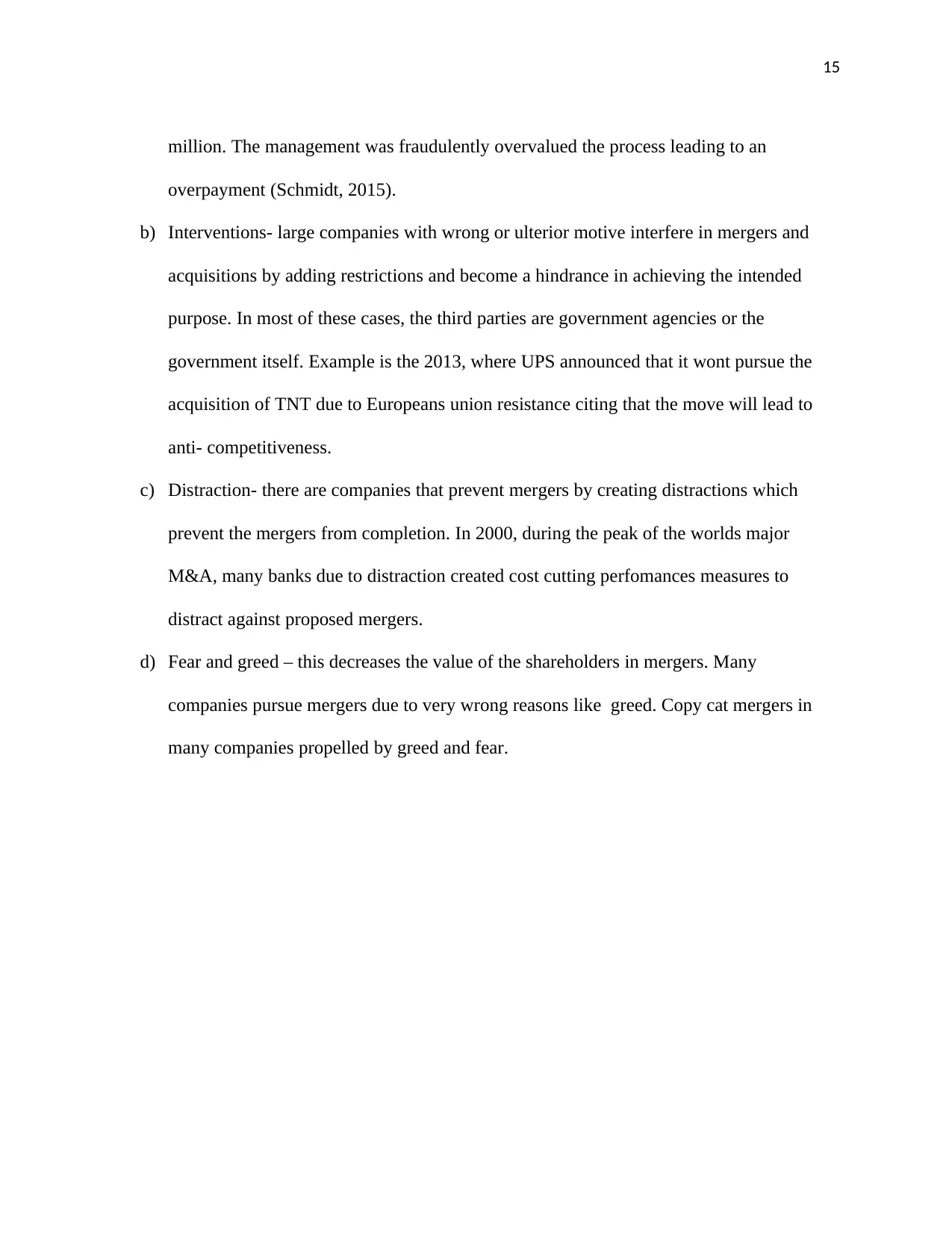
15
million. The management was fraudulently overvalued the process leading to an
overpayment (Schmidt, 2015).
b) Interventions- large companies with wrong or ulterior motive interfere in mergers and
acquisitions by adding restrictions and become a hindrance in achieving the intended
purpose. In most of these cases, the third parties are government agencies or the
government itself. Example is the 2013, where UPS announced that it wont pursue the
acquisition of TNT due to Europeans union resistance citing that the move will lead to
anti- competitiveness.
c) Distraction- there are companies that prevent mergers by creating distractions which
prevent the mergers from completion. In 2000, during the peak of the worlds major
M&A, many banks due to distraction created cost cutting perfomances measures to
distract against proposed mergers.
d) Fear and greed – this decreases the value of the shareholders in mergers. Many
companies pursue mergers due to very wrong reasons like greed. Copy cat mergers in
many companies propelled by greed and fear.
million. The management was fraudulently overvalued the process leading to an
overpayment (Schmidt, 2015).
b) Interventions- large companies with wrong or ulterior motive interfere in mergers and
acquisitions by adding restrictions and become a hindrance in achieving the intended
purpose. In most of these cases, the third parties are government agencies or the
government itself. Example is the 2013, where UPS announced that it wont pursue the
acquisition of TNT due to Europeans union resistance citing that the move will lead to
anti- competitiveness.
c) Distraction- there are companies that prevent mergers by creating distractions which
prevent the mergers from completion. In 2000, during the peak of the worlds major
M&A, many banks due to distraction created cost cutting perfomances measures to
distract against proposed mergers.
d) Fear and greed – this decreases the value of the shareholders in mergers. Many
companies pursue mergers due to very wrong reasons like greed. Copy cat mergers in
many companies propelled by greed and fear.
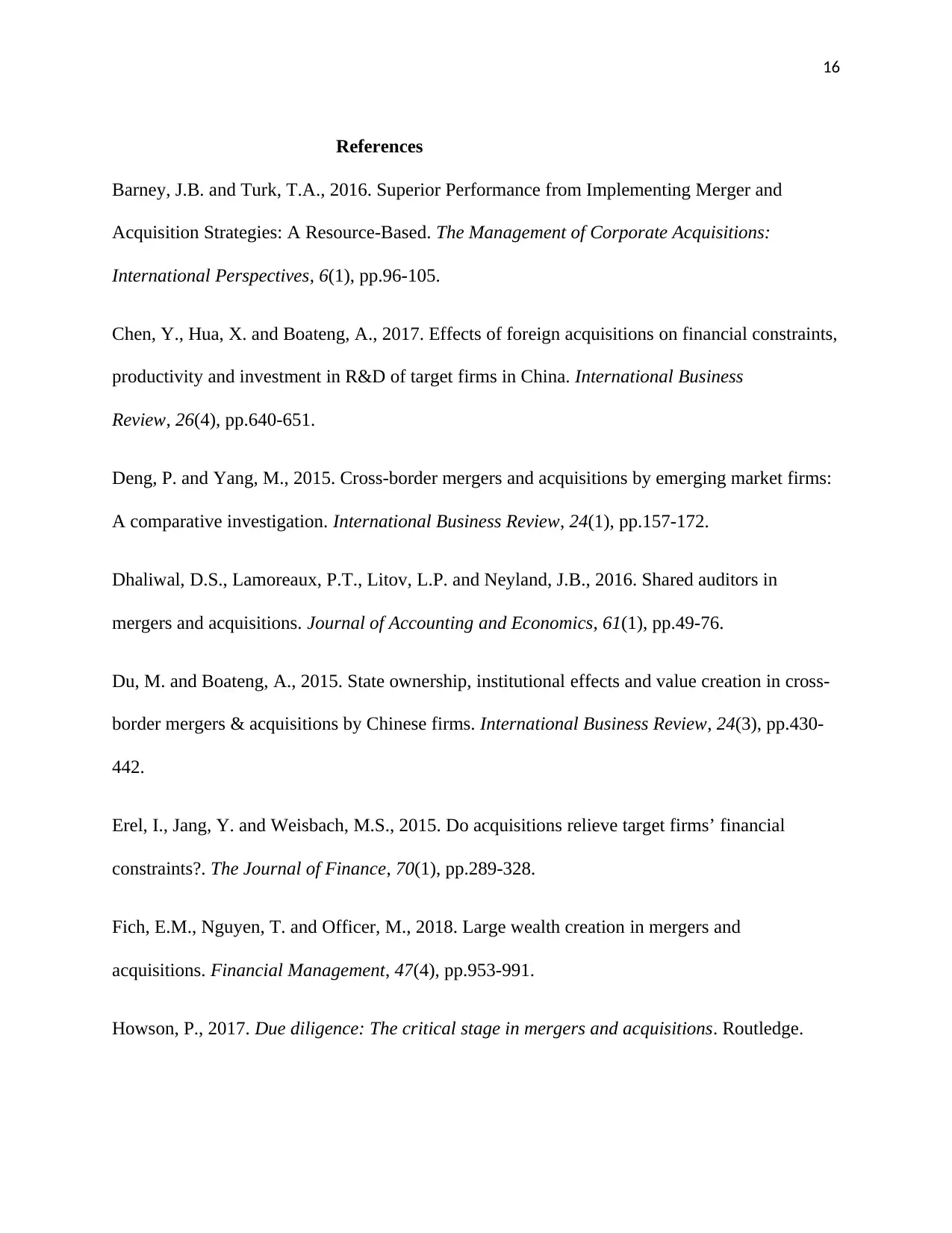
16
References
Barney, J.B. and Turk, T.A., 2016. Superior Performance from Implementing Merger and
Acquisition Strategies: A Resource-Based. The Management of Corporate Acquisitions:
International Perspectives, 6(1), pp.96-105.
Chen, Y., Hua, X. and Boateng, A., 2017. Effects of foreign acquisitions on financial constraints,
productivity and investment in R&D of target firms in China. International Business
Review, 26(4), pp.640-651.
Deng, P. and Yang, M., 2015. Cross-border mergers and acquisitions by emerging market firms:
A comparative investigation. International Business Review, 24(1), pp.157-172.
Dhaliwal, D.S., Lamoreaux, P.T., Litov, L.P. and Neyland, J.B., 2016. Shared auditors in
mergers and acquisitions. Journal of Accounting and Economics, 61(1), pp.49-76.
Du, M. and Boateng, A., 2015. State ownership, institutional effects and value creation in cross-
border mergers & acquisitions by Chinese firms. International Business Review, 24(3), pp.430-
442.
Erel, I., Jang, Y. and Weisbach, M.S., 2015. Do acquisitions relieve target firms’ financial
constraints?. The Journal of Finance, 70(1), pp.289-328.
Fich, E.M., Nguyen, T. and Officer, M., 2018. Large wealth creation in mergers and
acquisitions. Financial Management, 47(4), pp.953-991.
Howson, P., 2017. Due diligence: The critical stage in mergers and acquisitions. Routledge.
References
Barney, J.B. and Turk, T.A., 2016. Superior Performance from Implementing Merger and
Acquisition Strategies: A Resource-Based. The Management of Corporate Acquisitions:
International Perspectives, 6(1), pp.96-105.
Chen, Y., Hua, X. and Boateng, A., 2017. Effects of foreign acquisitions on financial constraints,
productivity and investment in R&D of target firms in China. International Business
Review, 26(4), pp.640-651.
Deng, P. and Yang, M., 2015. Cross-border mergers and acquisitions by emerging market firms:
A comparative investigation. International Business Review, 24(1), pp.157-172.
Dhaliwal, D.S., Lamoreaux, P.T., Litov, L.P. and Neyland, J.B., 2016. Shared auditors in
mergers and acquisitions. Journal of Accounting and Economics, 61(1), pp.49-76.
Du, M. and Boateng, A., 2015. State ownership, institutional effects and value creation in cross-
border mergers & acquisitions by Chinese firms. International Business Review, 24(3), pp.430-
442.
Erel, I., Jang, Y. and Weisbach, M.S., 2015. Do acquisitions relieve target firms’ financial
constraints?. The Journal of Finance, 70(1), pp.289-328.
Fich, E.M., Nguyen, T. and Officer, M., 2018. Large wealth creation in mergers and
acquisitions. Financial Management, 47(4), pp.953-991.
Howson, P., 2017. Due diligence: The critical stage in mergers and acquisitions. Routledge.
Secure Best Marks with AI Grader
Need help grading? Try our AI Grader for instant feedback on your assignments.
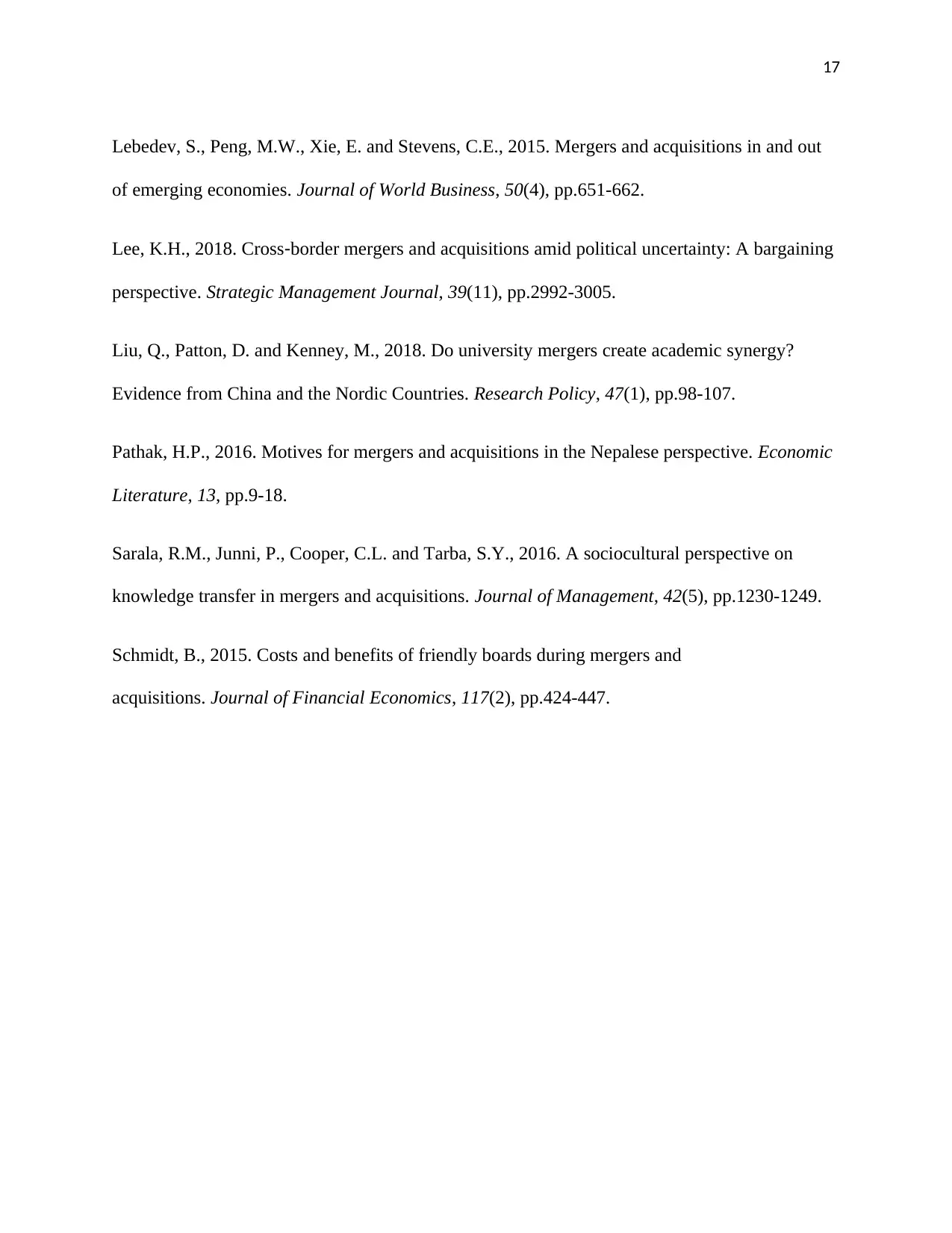
17
Lebedev, S., Peng, M.W., Xie, E. and Stevens, C.E., 2015. Mergers and acquisitions in and out
of emerging economies. Journal of World Business, 50(4), pp.651-662.
Lee, K.H., 2018. Cross‐border mergers and acquisitions amid political uncertainty: A bargaining
perspective. Strategic Management Journal, 39(11), pp.2992-3005.
Liu, Q., Patton, D. and Kenney, M., 2018. Do university mergers create academic synergy?
Evidence from China and the Nordic Countries. Research Policy, 47(1), pp.98-107.
Pathak, H.P., 2016. Motives for mergers and acquisitions in the Nepalese perspective. Economic
Literature, 13, pp.9-18.
Sarala, R.M., Junni, P., Cooper, C.L. and Tarba, S.Y., 2016. A sociocultural perspective on
knowledge transfer in mergers and acquisitions. Journal of Management, 42(5), pp.1230-1249.
Schmidt, B., 2015. Costs and benefits of friendly boards during mergers and
acquisitions. Journal of Financial Economics, 117(2), pp.424-447.
Lebedev, S., Peng, M.W., Xie, E. and Stevens, C.E., 2015. Mergers and acquisitions in and out
of emerging economies. Journal of World Business, 50(4), pp.651-662.
Lee, K.H., 2018. Cross‐border mergers and acquisitions amid political uncertainty: A bargaining
perspective. Strategic Management Journal, 39(11), pp.2992-3005.
Liu, Q., Patton, D. and Kenney, M., 2018. Do university mergers create academic synergy?
Evidence from China and the Nordic Countries. Research Policy, 47(1), pp.98-107.
Pathak, H.P., 2016. Motives for mergers and acquisitions in the Nepalese perspective. Economic
Literature, 13, pp.9-18.
Sarala, R.M., Junni, P., Cooper, C.L. and Tarba, S.Y., 2016. A sociocultural perspective on
knowledge transfer in mergers and acquisitions. Journal of Management, 42(5), pp.1230-1249.
Schmidt, B., 2015. Costs and benefits of friendly boards during mergers and
acquisitions. Journal of Financial Economics, 117(2), pp.424-447.
1 out of 17
Related Documents
Your All-in-One AI-Powered Toolkit for Academic Success.
+13062052269
info@desklib.com
Available 24*7 on WhatsApp / Email
![[object Object]](/_next/static/media/star-bottom.7253800d.svg)
Unlock your academic potential
© 2024 | Zucol Services PVT LTD | All rights reserved.





